 |
| A pontoon causeway is constructed during the Allied invasion of Sicily. |
The idea to use hollow, sheet steel boxes as pontoons and
pontoon-assembled structures originated in 1935. The standard pontoon unit and
the principle of stringing such units together was developed in 1939 by Captain
John N. Laycock of the Bureau of Yards and Docks and subsequently tested during
1940 and 1941.
When the United States entered World War II, the Navy was
faced for the first time with the problem of landing and supplying large forces
where conventional harbor facilities were occupied by the enemy. Naval officers
conversant with invasion landing problems foresaw that many problems could be
solved with assemblies of pontoon strings and conceived that they might be used
for wharves, docks, piers, lighters, tugs, and special-duty barges. The
importance of the contribution to the war effort made by the Seabees and their
pontoons cannot be overemphasized.
During World War II, PHIBCBs were designated Naval
Construction Battalions, Pontoon, and were generally called Pontoon Operating
Battalions. Pontoon-barge-mounted 75-ton booms unloaded PT boats from carriers
under the noses of the Japanese in the Solomons. Pontoon-floating dry docks
serviced damaged small craft in many parts of the world. Barge-mounted cranes
deepened harbors, and loaded and unloaded vessels. In the campaigns of Sicily,
Normandy, Italy, and the Philippines, causeways were indispensable in the rapid
unloading of vehicle-borne cargo from LSTs. Rhino and smaller barges ferried
cargo ashore, and pontoon tugs retrieved broached craft from the beaches,
helped tow barges, and assisted in the installation of piers and wharves.
All over the world, pontoon piers, wharves, and bridge units
were used to create harbors or to increase the facilities of existing ones. It
was learned during the invasion of Sicily that pontoon causeways provided an
excellent method of rapidly unloading vehicle-borne cargo from LSTs. The
shallow water of the southern beaches of Sicily effectively prevented LSTs from
moving in close enough to shore to discharge troops and cargo. Consequently,
the enemy made preparations for an assault from the north where the water was
deeper. By using causeways between LSTs and the shore, allied troops and cargo
were landed on the southern beaches and achieved the element of surprise.
In addition to the standard 5 x 7 x 5 ft. pontoon, a curved
bow pontoon was also made. These could be attached to standard pontoons to
create mobile barges, or Rhino ferries, powered by Murray-Tregurtha outboard
engines. Rhino ferries were typically 6 x 18 ft., 4 x 12 ft., or 3 x 7 ft.
individual pontoons. Other sizes of barges were also built.
Pontoons were used for a wide variety of purposes. The
Bureau of Yards and Docks published the Pontoon Gear Manual in 1944 listing 31
standard configurations. These included causeways, dry docks, finger piers, and
crane barges. Pontoons were also used to store gasoline.
The draft of a loaded LST (Landing Ship, Tank) ranged from
more than three feet forward to over nine feet aft. This draft was too deep for
LSTs to be beached and unloaded in many areas. So, pontoon causeways were often
used to help facilitate offloading. LSTs transported causeway sections slung on
shelves and secured by rope on the ship’s sides. They were released as the
vessel moved shoreward letting momentum carry the sections toward the shore
where one end was beached.
On Peleliu, pontoons were used for three primary purposes:
as causeways, barges, and in the construction of the harbor. Causeways were
constructed on Orange Beach 3 and on Purple Beach. The causeway at Orange Beach
3 was started on D-day September 15, 1944 and completed six days later. Seabees
and engineers built it under Japanese fire using bulldozers to clear coral
heads from the reef before the causeway could be installed. Six LSTs brought
pontoon causeway sections to Peleliu consisting of 2 x 30 pontoons, and were
approximately 175 ft. long and 14 ft. wide.
A storm destroyed the Peleliu causeways about two weeks
after they were constructed scattering pontoons over the beaches for several
miles. The causeways were quickly rebuilt and were back in operation within 24
hours. Pontoons composing the causeway at Orange 3 were filled with coral
rubble to prevent them being washed away again.
Landing craft other than DUKWs and LVTs generally could not
cross the shallow fringing reef at Peleliu, so moving cargo from ship to shore
was challenging. An innovative solution using motorized barges and cranes was
tried for the first time at Peleliu. Barges were outfitted with cranes in
landing operations such as Guadalcanal. However, these stationary barges were
vulnerable to enemy fire. Cranes mounted on barges, however, could move out of
range of Japanese fire when necessary. To address this issue, nine motorized
barges, each seven pontoons long and three wide, were transported to Peleliu
intact and slung on the sides of LSTs. When cut loose, they moved under their
own power to specially designated ships and each received a crane. From there
the barges went to stations on the reef. Landing craft loaded with cargo
approached from one side, and the crane picked up the cargo and transferred it
to an LVT or DUKW moored on the other side. In this way, cargo was efficiently
transferred from ship to beach. These crane-mounted barges were a successful
innovation.
Additionally, small pontoon rafts were used as intermediate
aid stations for wounded being transported by DUKW or LVT between Peleliu and
ships offshore. They were marked with a Red Cross insignia, consisted of six
pontoons, and were operated by one doctor and two corpsmen.
Construction of a channel and harbor began on October 20,
1944. The channel was located just south of the causeway at Orange 3. The
causeway became the northern bulkhead of the channel, and was eventually
covered with coral rubble. Cranes for dredging the channel were mounted on
barges and on the beach. Dredging continued 24 hours per day for three months.
Coral-filled pontoons were laid alongside the channel to form a dock on which
cranes could be mounted. Pontoons were also used to line the harbor to create
bulkheads and piers for a boat basin. This was the final stage of harbor
construction, and because they were no longer needed to support operations,
pontoons were taken from the barges and causeways used in the invasion. These
pontoons are still in evidence today at the harbor.
Navy Lighterage Pontoon
The Navy Lighterage pontoon (NLP) was a type of pontoon
developed in World War II by Capt. John N. Laycock Civil Engineer Corps (CEC)
and used by United States Navy Construction Battalions(Seabees) on invasion
beaches and shallow harbors or harbors where the facilities had been destroyed
or did not exist. It was referred to as the Seabee's "magic box". It
was Lego-like system of pre-cut pre-drilled angle iron and steel plate. It was
first assembled into individual boxes that were joined in multiples to
construct docks, causeways, barges, dry docks, floating cranes, marine railways
or whatever was needed.
Capt. Carl A. Carlson CEC of the War Plans Office came up
with the concept of NLPs in 1935, but it was in 1940 that the US Navy looked at
the idea more seriously. Development, with testing, began just before the US
entered World War II. The Dieppe Raid in early 1942 showed that the idea of
seizing a port in the face of modern coastal defenses was either costly or
impossible. The US Navy saw the vital importance of being able to build their
own port facilities and to deploy naval construction units trained and
dedicated for just that role. Creating the Seabees addressed that issue. Four
battalions were tasked as pontoon battalions and five Pontoon Assembly
Detachments (PADs) were formed. The US Army soon followed with their own units.
The Navy Pontoon opened new avenues of attack. The 2' x 175'
sections could be carried on sides of LSTs and could land on shallow water
beaches. They also were used to form an easy to assemble "in theater"
dry dock. The sections LSTs transported hanging on their sides could be used to
form the bottom and sides of a dry dock. They were modified to be filled or
pumped dry to sink or float as needed.
Pontoons were used to make support barges for waterfront
cranes.
Other barges were motorized, in whatever length and width
needed and called Rhinos. The assemblies were nearly unsinkable with the
multiple compartments interlocked together. Because they were assembled from
standardized pieces they were simple to repair.
Seabees could not do their job until they had equipment
ashore. Pontoons were run in front of a LCT or LST or they could ferry from
offshore.
Pontoons were as important as a Sherman, as it's what got
the fuel and ammo ashore.
The NLPs were constructed of welded steel flotation units
that were assembled like Legos, connected by special angle-iron pieces, called
stringers. The flotation boxes and stringers were held together by special iron
wedge pins. The flotation boxes came in two types: a rectangular basic unit
measuring 5 ft × 5 ft × 7 ft (1.5 m × 1.5 m × 2.1 m). The majority of NLPs were
constructed using these. The second type had one side that was curved or angled
to make a bow on the front of NLP barges or a ramp as needed.
 |
| Detail of pontoon secured to side of an LST. |
 |
| Pontoon dropped. |
 |
| Pontoon being retrieved. |
 |
| Pontoon stowed for sea. |
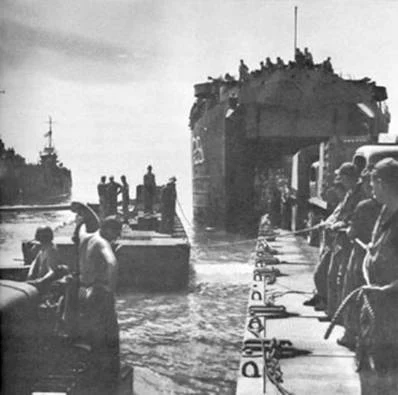 |
| Pontoon used to unload vehicles from an LST. |
 |
| A Landing Ship Tank (LST) unloads soldiers, sailors and cargo on a pontoon causeway during the Allied invasion of Sicily in World War II. July 1943. |
 |
| Pontoon causeway section being released from the side of an LST, Arzeu. |
 |
| Stockpile of pontoons at Port Hueneme. Note the absence of right angles at the corners of each pontoon. |
 |
| Pontoon causeways and LSTs at Purple Beach, Peleliu. |
 |
| Causeway on Peleliu at Orange Beach 3. |
 |
| While Italian prisoners of war are marched along a beach near Gela, Sicily, GIs watch U.S. Army trucks loaded with supplies drive from LST-336 along a pontoon causeway to the shore. First used during the invasion of Sicily, pontoon causeways would be employed widely in the Atlantic and Pacific theaters. |
 |
| Soldiers land on Peleliu using pontoon causeway. |
 |
| Pontoon barge with crane at Peleliu. |
 |
| Harbor at Peleliu. |
 |
| Remains of a pontoon used in the construction of the harbor at Peleliu. |
 |
| Tarakan, LST 993 unloading on a pontoon causeway, 1945. At front left is a GMC CCKW 2.5 ton 6x6 U.S. Army cargo truck, the remaining vehicles appear to be Jeeps towing trailers. Note the anti-aircraft gun turrets, three visible forward. USS LST-993 was an LST-542-class tank landing ship in the United States Navy. Like many of her class, she was not named and is properly referred to by her hull designation. |
 |
| D-Day+4: construction of pontoon causeway after Allied landings at Normandy. |
 |
| Causeway positioned on the side of an LST for the invasion of Sicily, 18 May 1943. |
 |
| Assembly of 1 x 30 string pontoon causeway for the invasion of Sicily. Pontoons lined up in the background. 18 May 1943. |
 |
| Assault equipment at LST pontoon causeway, White Beach, Tinian, 7 August 1944. Vehicle is an M5 High Speed Tractor, probably towing an artillery piece. |
 |
| LST unloading via causeway and an LCM using causeway as a dock, Sicily, 13 July 1943. |
 |
| Causeways being used as a main highway shortly after D-Day, Normandy. June 1944. |
 |
| The 111th Naval Construction Battalion landing at Omaha Beach before the Mulberry was installed, 6 June 1944. Ships unloading on the beach while barrage balloons hover overhead. The Seabees constructed and operated camps for naval personnel behind the invasion beaches. On D-Day+6, work began on a beach camp designed to accommodate 6,000 men. |
 |
| A Rhino Ferry manned by Seabees from the 111th Naval Construction Battalion provided a secret weapon of enormous value in establishing beachheads on the French coast during the D-Day invasion, 6 June 1944. Rhinos were used to unload equipment from an LST using a special unloading ramp placed opposite the engines. The Rhinos used 186 pontoons to assemble into a huge ferry. |
 |
| Seabees repairing pontoons on Guadalcanal, 1945. Naval Construction Battalion Maintenance Unit 518. |
 |
| Pier nearing completion to pontoon dock, Acorn Beach, Koli Point. Guadalcanal, 1942. |
 |
| Seabees testing first causeway in North Africa prior to the invasion of Sicily. 4 June 1943. |
 |
| Back of the Rhino Ferry, June 1944. |
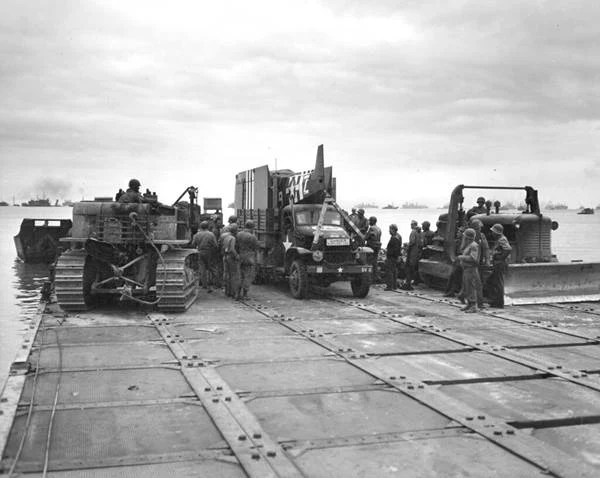 |
| Invasion vehicles getting ready to debark from the Seabee Rhino ferry, Normandy, June 1944. 111th Naval Construction Battalion. |
 |
| Small Rhino Ferry on D-Day, Normandy, 6 June 1944. 111th NCB. |
 |
| Seabees use a pontoon lighter barge to move a PBM aircraft on Okinawa. The pontoon barge was used to bring damaged and powerless planes to repair bases, the propulsion barge was built of the same 5’ by 7’ steel boxes used to construct causeways and supply barges. May 1945. 70th Naval Construction Battalion. |
 |
| Seabees moving 6 x 20 barge used to move seaplanes. Okinawa, May 1945. 70th Naval Construction Battalion. |
 |
| Crane on top of a pontoon being used to dredge the lagoon. August 1943. |
 |
| Seabees offload heavy equipment onto the floating harbor causeway. Normandy, 23 October 1944. 111th Naval Construction Battalion. |
 |
| Seabees use Rhino Ferries to offload equipment from the LSTs. Normandy, June 1944. 111th Naval Construction Battalion. |
 |
| Troops and equipment load aboard a Seabee Rhino ferry from LST at Normandy, June 1944. 111th Naval Construction Battalion. |
 |
| While blimps scout the skies, the Seabees smooth out the beach and build a "sand causeway" to the ramp of a Rhino ferry. Normandy, June 1944. 111th Naval Construction Battalion. |
 |
| Troops using Seabee built pontoon causeways to come ashore from their landing craft. Normandy, June 1944. 111th Naval Construction Battalion. |
 |
| Whale causeways -- steel pontoon bridges which connected the Lobnitz Pierheads to the shore -- were towed from England on barges. Normandy, June 1944. 111th Naval Construction Battalion. |
 |
| Seabees work on a floating repair shop they created on the causeways off the coast of Utah Beach. Normandy, June 1944. 111th Naval Construction Battalion. |
 |
| Rhino ferry powered by its outboard motors. The ferries are formed of 30 pontoons in length and are equal in strength to a civilian highway bridge. Normandy, June 1944. 111th Naval Construction Battalion. |
 |
| The Mulberry at Normandy had large concrete and/or steel pontoons installed at regular intervals for strengthening. Omaha shoreline is viewed in background. Normandy, June 1944. 111th Naval Construction Battalion. |
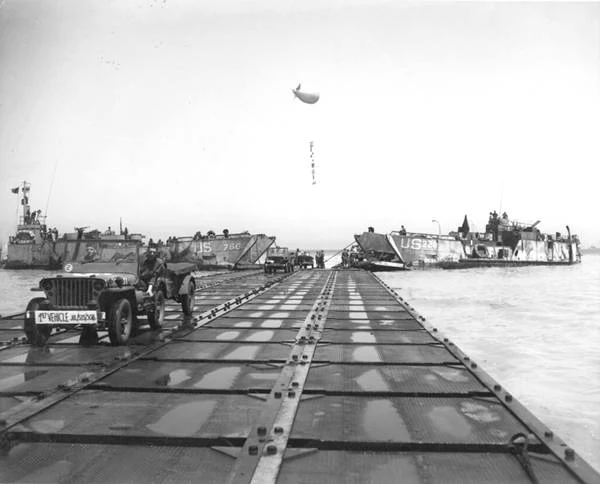 |
| Four pontoon causeway, 28 ft. wide, laid at Utah Beach, Normandy by the Seabees of 1006th Construction Battalion Detachment. Flags hanging from barrage balloons signal location of causeway for incoming landing craft. June 1944. 111th Naval Construction Battalion. |
 |
| A rhino ferry married to an LST during the Normandy invasion. To provide for the needs at Omaha and Utah beaches, the Seabees at their British bases assembled 36 rhino ferries. In addition, they assembled 12 causeway tugs; 12 warping tugs; two rhino repair barges with a 5-ton crane and toll house each; and 2 floating dry docks with enough capacity to dock an LST. Normandy, June 1944. 111th Naval Construction Battalion. |
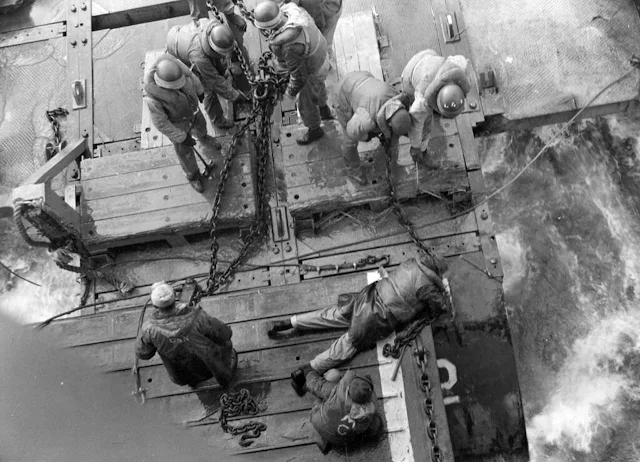 |
| The 81st Naval Construction Battalion marrying up a rhino ferry to an LST during the invasion of Normandy, pictured here June 6, 1944. The battalion was assigned to operate the rhino ferries dispatched to Utah Beach while in tow across the British Channel. They were also charged with operating the rhino ferries and beach camp at Omaha Beach. Normandy, June 1944. |
 |
| Barge #12, with loaded fuel, is in sinking condition off Blue Beach. Note the water running from holes in starboards #7 and #9 on Iwo Jima. 24 February 1945. |
 |
| 111th Naval Construction Battalion lowers equipment to beaches by ramp while cargo is put on the beach. Normandy, June 1944. 111th Naval Construction Battalion. |
 |
| Seabees with the 111th Naval Construction Battalion shuttle equipment by Rhino Ferry to the beaches at Normandy as part of Operation Neptune. Normandy, June 1944. 111th Naval Construction Battalion. |
 |
| Celebrating their third year, feeling proud of their accomplishments of building an artificial floating harbor and mobile ship repair on large pontoons. Normandy, June 1944. 111th Naval Construction Battalion. |
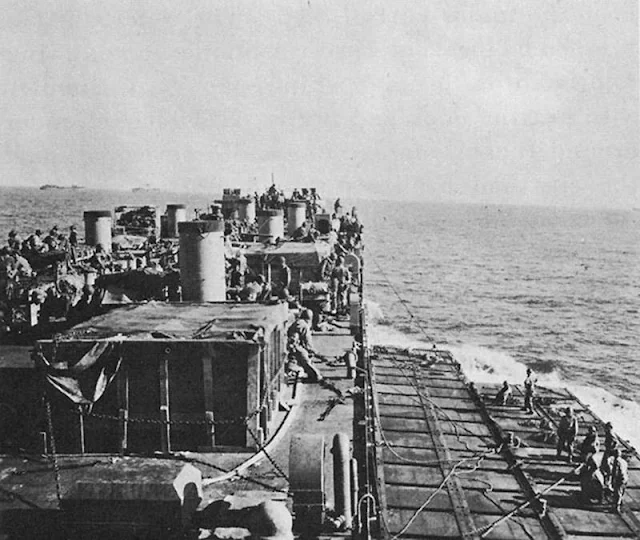 |
| Pontoons in the Sicilian invasion, July 10, 1943. Pontoons of Platoon J of the 1006th Seabees, secured alongside LST-388 on the run into Blue Beach, Licata. |
 |
| 1006th Seabees in the Salerno invasion unloading an LST over a pontoon causeway at Safta Beach. |
 |
| 1006th Seabees using a three-section pontoon causeway at Safta Beach. |
 |
| U.S. troops land from a pontoon bridge serving as a pier during the U.S. invasion of the Marshall Islands in 1944. |
 |
| Pontoon causeway and barge in Charan Kanoa Harbor, Saipan. |
 |
| The pontoon causeway at “Omaha” beach, forming part of the U.S. Mulberry the man-made harbor off coast of France, built to protect landing craft from storms in English Channel. Note LCT 525. Normandy, June 1944. |
 |
| The pontoon causeway at “Omaha” beach, forming part of the U.S. Mulberry the man-made harbor off coast of France, built to protect landing craft from storms in English Channel. Note LCT 525. Normandy, June 1944. |
 |
| Unloading a Rhino ferry at Normandy, June 1944. |
 |
| Rhino ferry transporting various vehicles and a barrage balloon at Normandy, June 1944. |
 |
| Rhino ferries at Normandy, June 1944. |
 |
| Pontoon pier at Katchin-Hanto, Okinawa, May 1945. |
 |
| Wrecked pontoon causeway of one of the "Mulberry" artificial harbors, following the storm of 19-22 June 1944. |
 |
| U.S. troops coming ashore courtesy of Mulberry A at St Laurent-sur-Mer, Normandy, June 1944. |
 |
| Storm wreckage including pontoon sections at Omaha Beach, Normandy, June 1944. |
 |
| Construction of sand bridge by bulldozers to meet pontoon bridge during amphibious training exercises. Bulldozers of the 321st Infantry Regiment, 81st Division, building a causeway from the beach out to the pontoon barge used to load the LST. Action took place at Avila Beach, California. 15 March 1944. |
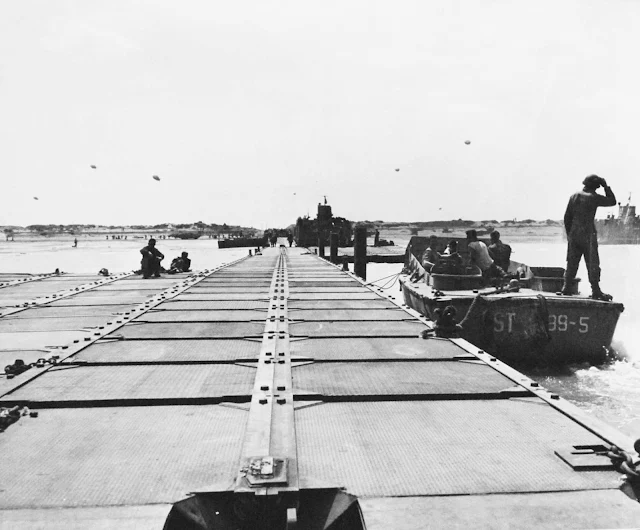 |
| Pontoon causeway stretching from Allied beachhead in Normandy, France. LCT’s are unloading. An LCVP is tied up at right. Nearer shore, LCT 447 is unloading. |
 |
| Capt. John N. Laycock CEC discussing his modular pontoon box system with Admiral Moreell CEC, chief of the Bureau of Yards and Docks. |
 |
| Seabees unloading ships with pontoons at Lingayen Gulf, Luzon in January 1945. |
 |
| Navy Lighterage. |
 |
| Navy Lighterage sections. |
 |
| Seabee’s have “married” a pontoon causeway to an LST to offload the ship’s cargo to shore. 1944. |







































































No comments:
Post a Comment